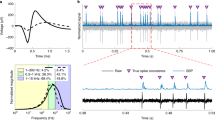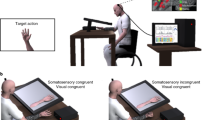Abstract
Recent studies have demonstrated that monkeys1,2,3,4 and humans5,6,7,8,9 can use signals from the brain to guide computer cursors. Brain–computer interfaces (BCIs) may one day assist patients suffering from neurological injury or disease, but relatively low system performance remains a major obstacle. In fact, the speed and accuracy with which keys can be selected using BCIs is still far lower than for systems relying on eye movements. This is true whether BCIs use recordings from populations of individual neurons using invasive electrode techniques1,2,3,4,5,7,8 or electroencephalogram recordings using less-6 or non-invasive9 techniques. Here we present the design and demonstration, using electrode arrays implanted in monkey dorsal premotor cortex, of a manyfold higher performance BCI than previously reported9,10. These results indicate that a fast and accurate key selection system, capable of operating with a range of keyboard sizes, is possible (up to 6.5 bits per second, or ∼15 words per minute, with 96 electrodes). The highest information throughput is achieved with unprecedentedly brief neural recordings, even as recording quality degrades over time. These performance results and their implications for system design should substantially increase the clinical viability of BCIs in humans.
This is a preview of subscription content, access via your institution
Access options
Subscribe to this journal
Receive 51 print issues and online access
$199.00 per year
only $3.90 per issue
Buy this article
- Purchase on Springer Link
- Instant access to full article PDF
Prices may be subject to local taxes which are calculated during checkout



Similar content being viewed by others
References
Serruya, M. D., Hatsopoulos, N. G., Paninski, L., Fellows, M. R. & Donoghue, J. Instant neural control of a movement signal. Nature 416, 141–142 (2002)
Taylor, D. M., Tillery, S. I. H. & Schwartz, A. B. Direct cortical control of 3D neuroprosthetic devices. Science 296, 1829–1832 (2002)
Carmena, J. M. et al. Learning to control a brain-machine interface for reaching and grasping by primates. PLoS Biol. 1, E42 (2003)
Musallam, S., Corneil, B. D., Greger, B., Scherberger, H. & Andersen, R. A. Cognitive control signals for neural prosthetics. Science 305, 258–262 (2004)
Kennedy, P. R., Bakay, R. A. E., Moore, M. M., Adams, K. & Goldwaithe, J. Direct control of a computer from the human central nervous system. IEEE Trans. Rehabil. Eng. 8, 198–202 (2000)
Leuthardt, E. C., Schalk, G., Wolpaw, J. R., Ojemann, J. G. & Moran, D. W. A brain-computer interface using electrocorticographic signals in humans. J. Neural Eng. 1, 63–71 (2004)
Hochberg, L. R., Mukand, J., Polykoff, G., Friehs, G. & Donoghue, J. Braingate Neuromotor Prosthesis: Nature and Use of Neural Control Signals. Program No. 520.17, 2005 Abstract Viewer/Itinerary Planner (Society for Neuroscience, Washington DC, 2005)
Patil, P. G., Carmena, J. M., Nicolelis, M. A. L. & Turner, D. A. Ensemble recordings of human subcortical neurons as a source of motor control signals for a brain-machine interface. Neurosurgery 55, 27–38 (2004)
Wolpaw, J. & McFarland, D. Control of a two-dimensional movement signal by a noninvasive brain-computer interface in humans. Proc. Natl Acad. Sci. USA 101, 17849–17854 (2004)
Taylor, D. M., Tillery, S. I. H. & Schwartz, A. B. Information conveyed through brain-control: cursor vs. robot. IEEE Trans. Neural Syst. Rehabil. Eng. 11, 195–199 (2003)
Shenoy, K. V. et al. Neural prosthetic control signals from plan activity. Neuroreport 14, 591–596 (2003)
Cisek, P. & Kalaska, J. F. Neural correlates of mental rehearsal in dorsal premotor cortex. Nature 431, 993–996 (2004)
Messier, J. & Kalaska, J. F. Covariation of primate dorsal premotor cell activity with direction and amplitude during a memorized-delay reaching task. J. Neurophysiol. 84, 152–165 (2000)
Yu, B. M., Ryu, S. I., Santhanam, G., Churchland, M. M. & Shenoy, K. V. Improving Neural Prosthetic System Performance by Combining Plan and Peri-movement Activity 4516–4519 (Proc. 26th Annu. Int. Conf. IEEE EMBS, San Francisco, California, 2004).
Churchland, M. M., Yu, B. M., Ryu, S. I., Santhanam, G. & Shenoy, K. V. Neural variability in premotor cortex provides a signature of motor preparation. J. Neurosci. 26, 3697–3712 (2006)
Yu, B. M. et al. Extracting dynamical structure embedded in neural activity. In Advances in Neural Information Processing Systems 18 (eds Weiss, Y., Schölkopf, B. & Platt, J.) (MIT Press, Cambridge, Massachusetts, 2006)
Dayan, P. & Abbott, L. F. Theoretical Neuroscience: Computational and Mathematical Modeling of Neural Systems (MIT Press, Cambridge, Massachusetts, 2001)
Shannon, C. E. A mathematical theory of communication. Bell Syst. Tech. J. 27, 379–423 and 623–656 (1948)
Polikov, V. S., Tresco, P. A. & Reichert, W. M. Response of brain tissue to chronically implanted neural electrodes. J. Neurosci. Methods 148, 1–18 (2005)
Cisek, P. & Kalaska, J. F. Modest gaze-related discharge modulation in monkey dorsal premotor cortex during a reaching task performed with free fixation. J. Neurophysiol. 88, 1064–1072 (2002)
Batista, A. et al. Heterogeneous Coordinate Frames for Reaching in Macaque PMd. Program No. 363.12, 2005 Abstract Viewer/Itinerary Planner (Society for Neuroscience, Washington DC, 2005)
Santhanam, G., Sahani, M., Ryu, S. I. & Shenoy, K. V. An Extensible Infrastructure for Fully Automated Spike Sorting During Online Experiments 4380–4384 (Proc. 26th Annu. Int. Conf. IEEE EMBS, San Francisco, California, 2004).
Cover, T. & Thomas, J. Elements of Information Theory (John Wiley, New York, 1990)
Acknowledgements
We thank S. Eisensee for administrative assistance, M. Howard for surgical assistance and veterinary care, and N. Hatsopoulos for surgical assistance (monkey G implant). We also thank M. Churchland and M. Sahani for scientific discussions; E. Knudsen and T. Moore for comments on the manuscript; and A. Batista for collecting the blink-memory data. This study was supported by NDSEG Fellowships (G.S. and B.M.Y.), NSF Graduate Research Fellowships (G.S. and B.M.Y.), the Christopher Reeve Foundation (S.I.R. and K.V.S.), Bio-X Fellowship (A.A.), the NIH Medical Scientist Training Program (A.A.), and the following awards to K.V.S.: a Burroughs Wellcome Fund Career Award in the Biomedical Sciences, the Stanford Center for Integrated Systems, the NSF Center for Neuromorphic Systems Engineering at Caltech, ONR Adaptive Neural Systems, the Sloan Foundation, and the Whitaker Foundation. Author Contributions G.S. and S.I.R. contributed equally to this work. S.I.R. was responsible for the initial experimental concept and surgical implantation; G.S. and S.I.R. were responsible for experimental design, animal training, data collection and preliminary analysis; G.S. was responsible for infrastructure development, in-depth analysis and writing of the paper. B.M.Y. and A.A. participated in animal training, data collection and analysis. K.V.S. was involved in all aspects of the study.
Author information
Authors and Affiliations
Corresponding author
Ethics declarations
Competing interests
Reprints and permissions information is available at npg.nature.com/reprintsandpermissions. The authors declare no competing financial interests.
Supplementary information
Supplementary Notes
This file contains Supplementary Video Legends, Supplementary Discussion, Supplementary Methods, Supplementary Figures 1–7 and Supplementary Table 1. The Supplementary Discussion covers the following topics: motor-related activity in the absence of the visual stimulus, selection of Tskip, ITRC for multi-target task, ITRC comparisons with monkey G, effects of losing neural units on single-trial accuracy, and EMG measurements. (PDF 433 kb)
Supplementary Video 1
Instructed-delay task. This video shows the monkey's performance in the instructed-delay task. Trials were started by touching the center square and fixating the cross. The reach target appeared in the periphery and the monkey was required to wait until the 'go' cue before making the reach. (MPG 4777 kb)
Supplementary Video 2
Moderately-paced BCI experiments. This video shows the monkey's performance during a moderately-paced BCI experiment. Video annotations are used to denote real reaches and prosthetic cursor trials (not seen by monkey). (MPG 4512 kb)
Supplementary Video 3
Fast-paced BCI experiments. This video shows the monkey's performance during a fast-paced BCI experiment. The video contains three separate sequences, each of five cursor trials followed by a real reach. The three sequences were performed at different times in the experiment. (MPG 2866 kb)
Rights and permissions
About this article
Cite this article
Santhanam, G., Ryu, S., Yu, B. et al. A high-performance brain–computer interface. Nature 442, 195–198 (2006). https://doi.org/10.1038/nature04968
Received:
Accepted:
Issue Date:
DOI: https://doi.org/10.1038/nature04968
This article is cited by
-
Neuronal travelling waves explain rotational dynamics in experimental datasets and modelling
Scientific Reports (2024)
-
Residual dynamics resolves recurrent contributions to neural computation
Nature Neuroscience (2023)
-
Synchronous motor imagery and visual feedback of finger movement elicit the moving rubber hand illusion, at least in illusion-susceptible individuals
Experimental Brain Research (2023)
-
Electroencephalogram based brain-computer interface: Applications, challenges, and opportunities
Multimedia Tools and Applications (2023)
Comments
By submitting a comment you agree to abide by our Terms and Community Guidelines. If you find something abusive or that does not comply with our terms or guidelines please flag it as inappropriate.



